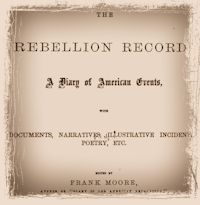March 7.—The first negro prisoners of war arrived in Richmond, Va., and were placed in Libby Prison. The Examiner thus noticed the fact: “They were genuine, sure members of the original Corps d’Afrique, ranging in color from gingerbread-brown to tobacco-black, greasy and loud-smelling, encased in blue uniforms, close buttoned up to the chin. They were captured on the second instant, within a few miles of Williamsburgh, with arms in their hands, having been pushed forward by Massa Butler with a negro command on a foraging and thieving expedition. Their names and military connection were recorded as follows: James W. Cord and P. F. Lewis, Fifth United States volunteers; R. P. Armstead and John Thomas, Sixth United States volunteers. As they claimed to be ‘Butler’s pets,’ and it being understood that a great affection and fondness for each other existed between them and the officers captured from the recent sacking and plunder expedition, Major Turner very considerately ordered that they be placed in the cells occupied by their white co-patriots, each being accommodated with a sable boon companion. We are glad that our officials are inclined to carry out Greeley’s idea of amalgamation of the races, so far as it affects the Yankee prisoners in our care. It will result in mutual good. The only party likely to be seriously affected, either in status or morals, is the negro. The Yankee cannot be degraded lower; the negro probably can be.”
—Under the caption of “A Premium Uniform,” the Richmond newspapers published the following: “Recently Mrs. White, of Selma, Alabama, went through the lines to Lexington, Kentucky, and being a sister (Todd) of Mrs. Lincoln, was permitted to go on to Washington. On her return, several weeks ago, she was allowed to carry nothing back, save a uniform for a very dear friend of hers who was battling in the Southern cause. The uniform arrived in the Confederacy several days since, and on inspection all the buttons were found to be composed of gold coin—two and a half, five, ten, and twenty-dollar gold pieces, set in the wooden button and covered with confederate cloth. The gold thus brought through is valued at between thirty and forty thousand dollars—all sewed upon a uniform.”
—Considerable excitement existed in Frederick and Washington counties, Md., growing out of rebel movements on the Virginia side of the Potomac, supposed to be premonitory of a cavalry raid through the upper counties of the State.
—Decatur, Alabama, was captured by the National forces under the command of Brigadier General Dodge.



